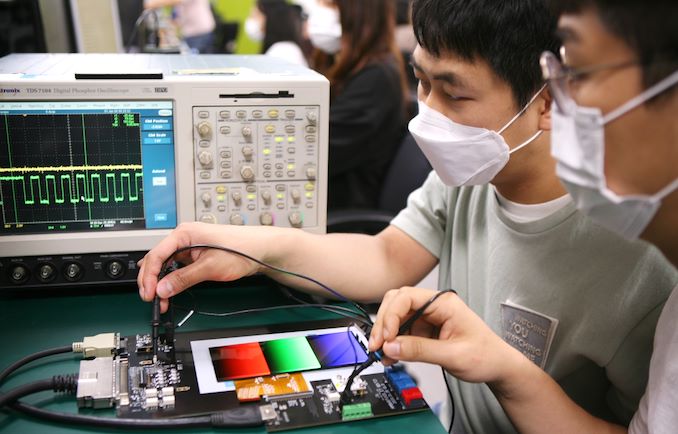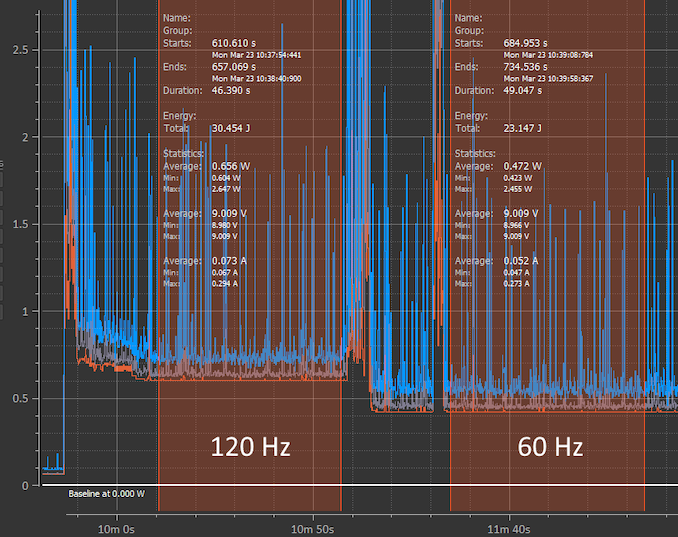Samsung Display Announces First VRR Mobile Display - Inside Note20 Ultra
by Andrei Frumusanu on August 11, 2020 7:00 PM EST
By now we’ve become quite familiar with high refresh-rate displays in the mobile space, as the first pioneering 90Hz devices last year have now evolved into even faster refreshing 120Hz smartphones becoming the standard. Although all these devices provide augmented user experiences by providing extra smooth scrolling and gaming experiences, they all come with notable compromises when it comes to power efficiency and battery life.
Today, Samsung Display is announcing that they are for the first time revealing new generation display panels that allow for variable refresh rate technology, alleviating one of the biggest draw-backs of current generation high-refresh-rate smartphones. The new technology is makings its debut in the new Galaxy Note20 Ultra, which should be available to the public in just two short weeks.
Currently, the biggest issue for devices using a high refresh rate display is the fact that all current implementation still functions at a certain fixed refresh rate no matter what the screen content is, meaning they always stick to either 60, 90 or 120Hz depending on the smartphone.
This year’s smartphones with 120Hz display in particular have seen the effect of drastically increased power draw when operating under this higher refresh-rate. Although these phones offer the ability to switch between different refresh rates, one cannot call these mechanisms variable refresh rate (VRR) displays as they cannot seamlessly and quickly switch between these modes. As such, even when you’re displaying a fixed static screen, the display continues to refresh at 120Hz and incurs a large power draw penalty, which is less than ideal.
Samsung’s new display panel employed in the new Note20 Ultra is actually described as a VRR panel, with Samsung promising new refresh rate modes such as the ability to operate at 120, 60, 30 and 10Hz modes. The latter super-low refresh rates have been to date never been used in smartphones. Samsung describes that the display will now be able to lower itself down to this new 10Hz mode when viewing static content.
"Existing smartphone panels offer only a fixed refresh rate. They cannot automatically calibrate a phone’s refresh rate, which would result in image flickering caused by luminance differences at lower refresh rates. Samsung Display’s new backplane** technology eliminates flickering for operating frequencies as low as 10Hz."
Samsung describes the usage of a new backplane technology in order to achieve this – whilst we haven’t had an official response from Samsung to our questions on the matter, there’s been rumours that this is the generation in which the company has introduced LTPO backplane technology, allowing it higher switching performance and lower power consumption.
Another question which remains to be answered is exact details on Samsung’s VRR workings, and whether it is a proper implementation of adaptive sync technology and if it has finer refresh rate granularity in the 10-120Hz beyond just the mentioned 60 and 30Hz examples.
Currently such a VRR implementation would also require a deeper software stack integration into the OS, GPU driver and display driver to fully enable it a seamless operation that would work transparently on any kind of static or low-framerate content – we’ll have to investigate this topic more once Note20 Ultra devices are officially out.
Samsung claims that the new technology should be able to reduce the phone’s display panel power usage by 22% in general use. Furthermore, there’s a statement of it only using 60% of the power of current screens when it is operating in super-low 10Hz mode – although both these figures don’t specify to which baseline they’re being compared to (60 or 120Hz displays?).
Update: Samsung clarified that 10Hz operates at 40% power of 120Hz baseline, thus reducing power by 60%. Seemingly The 60% power figure is comprared to 60Hz baseline.
Beyond making 120Hz a viable option for daily usage without major battery impact, the new technology should have the potential to improve power efficiency even beyond current 60Hz displays, which hopefully would usher in notably increased battery life in upcoming next-gen devices.











30 Comments
View All Comments
d0nk3y - Tuesday, August 11, 2020 - link
Is that *their* first VRR display - or the first VRR display in a smartphone? Apple has had VRR rate displays in the iPad and watch for a few years now.SirDragonClaw - Tuesday, August 11, 2020 - link
The ipad doesn't use a VRR screen, it cannot dynamically change framerate frequently and with the precision that a VRR display can. The ipad has 4 different modes, and will simply swap to the one that most closely matches the framerate of the content.From what samsung announced at their show, this screen can dynamically adjust multiple times a second so can be on 10hz when you are on a webpage reading but as soon as the system detects input can ramp up to 60-120hz depending on the speed of the movement.
It also seems like this will act like freesync and allow the display to tie its refresh to each new frame of a game, greatly reducing input latency, although this is not confirmed yet.
ksec - Wednesday, August 12, 2020 - link
Well how long does it take to adjust the frame rate though? Since there will obviously be latency in switching.Luminar - Wednesday, August 12, 2020 - link
Should be less than 16.67 ms if my sources are correct.NextGen_Gamer - Wednesday, August 12, 2020 - link
I am fairly sure that the iPad Pro has a true VRR panel - for games in particular, it operates just as a G-SYNC or FreeSync monitor would, it matches the framerate of a game precisely from 24-120Hz, and is always dynamically adjusting itself depending on what you are doing. Scrolling a web page will crank it to 120Hz, pause to read even for a tenth of a second, and it ramps down to 30Hz.dontlistentome - Wednesday, August 12, 2020 - link
As mentioned above, that's not VRR, it's switching between several fixed rates.VRR waits on each individual frame to be ready - this is then sent to the display which holds it until the next one is received.
NextGen_Gamer - Wednesday, August 12, 2020 - link
But I literally said that in games, it waits on each individual frame to be ready and then sent to the panel - just as G-SYNC or FreeSync does... sooooooo...melgross - Wednesday, August 12, 2020 - link
The iPad can have two different display rates at the same time though, which this can’t. I’ve got an iPad Pro, and it’s obvious when that’s happening.Duraz0rz - Tuesday, August 11, 2020 - link
First VRR display in a smartphone. They have VRR desktop monitors already.Vince789 - Wednesday, August 12, 2020 - link
First AMOLED VRR display in a smartphoneThe Razor Phone 1/2 had a VRR IPS displays